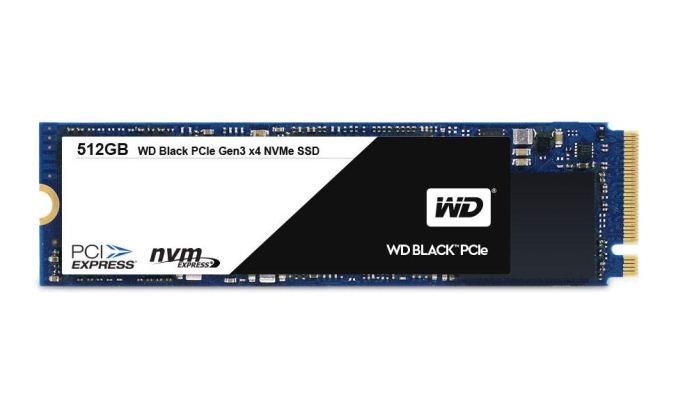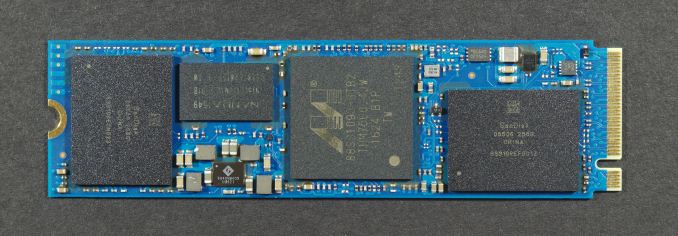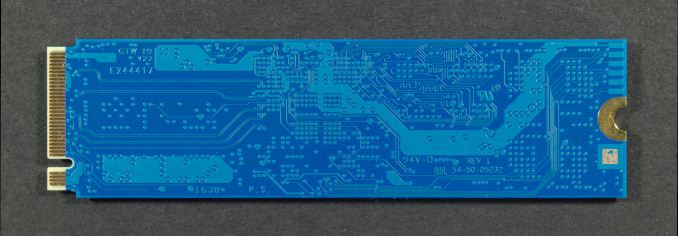The Western Digital Black PCIe SSD (512GB) Review
by Billy Tallis on March 8, 2017 8:30 AM EST
After acquiring SanDisk and introducing WD Green and WD Blue SSDs, it is no surprise to see Western Digital introduce a WD Black SSD that is a M.2 PCIe drive. In keeping with SanDisk's recent trends for mainstream consumer SSDs, the WD Black uses a Marvell controller (the 88SS1093, also seen in the Plextor M8Pe) and uses SanDisk's 15nm TLC NAND flash. And yes, the blue PCB is another SanDisk hallmark, even though it clashes with Western Digital's branding for the drive.
Western Digital and SanDisk are relatively late in bringing a consumer NVMe SSD to market. They're clearly intending for the WD Black SSD to be a fairly mainstream product by using TLC NAND and pricing it below high-end SATA SSDs. In the SATA space SanDisk has made very effective use of their planar TLC and the SanDisk X400 and WD Blue are the best in their class. Having taken their time developing the WD Black, we expect another solid performer. However, time is running out for planar TLC the WD Black may turn out to be a short-lived product before being replaced by a successor with 3D NAND. All four major NAND manufacturers plan to ship 64+ layer 3D NAND this year with TLC parts up to 512Gb, and if things go according to plan for at least two or three of them we should see the NAND shortage start to fade and prices and capacities improve.
| WD Black PCIe SSD Series Specifications | |||
| Capacity | 256GB | 512GB | |
| Form Factor | M.2 2280 | ||
| Interface | PCIe 3.0 x4 NVMe | ||
| Controller | Marvell 88SS1093 | ||
| NAND | SanDisk 15nm TLC | ||
| Sequential Read | 2050 MB/s | ||
| Sequential Write | 700 MB/s | 800 MB/s | |
| Random Read (4 KB) IOPS | 170k | 170k | |
| Random Write (4 KB) IOPS | 130k | 134k | |
| Power | Peak | 8.25 W | |
| Idle | 5.5 mW | ||
| Endurance | 80 TBW | 160 TBW | |
| Encryption | none | ||
| Warranty | 5 years | ||
| MSRP | $109 | $199.99 | |
The WD Black comes in only the two capacities that should be most popular: 256GB and 512GB. A 128GB PCIe SSD risks squandering much of the advantage of the faster interface due to the low number of NAND dies being a bottleneck, and 1TB PCIe SSDs are still expensive enough to be substantially less popular. A 1TB version would also need to be a double-sided M.2 module, which would limit compatibility with some laptops. As expected for a TLC SSD, the rated read performance is much higher than the write performance, though Western Digital does still give the WD Black a very nice looking random write rating. The endurance ratings for the WD Black are a little lower than I'd like to see given that even a TLC-based PCIe SSD is something of a premium product, but the five year warranty is quite reasonable.
Western Digital is currently taking pre-orders for the WD Black at MSRP and projecting a ship date of March 14, while there are already some third-party Amazon sellers offering it above MSRP. The MSRPs are about 10% higher than the current prices for the Intel SSD 600p, the current cheapest and slowest PCIe SSD.
For this review we will be comparing the 512GB WD Black primarily against other PCIe SSDs of similar capacity, and against a handful of the better SATA SSDs currently on the market. Some specific competitors to keep an eye on:
- The Plextor M8Pe uses the same Marvell controller and Toshiba's 15nm MLC counterpart to the 15nm TLC used by the WD Black.
- The WD Blue uses the same NAND as the WD Black, but a Marvell SATA SSD controller instead of the PCIe NVMe controller.
- The Intel SSD 600p based on Intel 3D TLC NAND and Silicon Motion's SM2260 controller is currently the cheapest and slowest NVMe SSD.
- The Samsung 960 EVO is the TLC PCIe SSD that's positioned above the WD Black in the market, and is the more mainstream of Samsung's current NVMe offerings.
| AnandTech 2015 SSD Test System | |
| CPU | Intel Core i7-4770K running at 3.5GHz (Turbo & EIST enabled, C-states disabled) |
| Motherboard | ASUS Z97 Pro (BIOS 2702) |
| Chipset | Intel Z97 |
| Memory | Corsair Vengeance DDR3-1866 2x8GB (9-10-9-27 2T) |
| Graphics | Intel HD Graphics 4600 |
| Desktop Resolution | 1920 x 1200 |
| OS | Windows 8.1 x64 |
- Thanks to Intel for the Core i7-4770K CPU
- Thanks to ASUS for the Z97 Deluxe motherboard
- Thanks to Corsair for the Vengeance 16GB DDR3-1866 DRAM kit, RM750 power supply, Carbide 200R case, and Hydro H60 CPU cooler












36 Comments
View All Comments
dgingeri - Wednesday, March 8, 2017 - link
At least they priced it about right. It's more expensive than the Intel 600p, but far less expensive than the 960 EVO and slightly less expensive than the M8Pe. This part of the market is odd. Usually, the fastest performing parts are FAR more expensive for just a small return on performance. In SSDs right now, the differences in price are fairly small, but the differences in performance are huge. I think the 960 EVO is about the best deal for a SSD, and this thing is just a shame to the "Black" label.Guspaz - Wednesday, March 8, 2017 - link
So, the product called "WD Black" is coloured blue, but there is also a "WD Blue" product? Let me guess, that one has a black PCB?Gasaraki88 - Wednesday, March 8, 2017 - link
Nope, it would have made sense if they spent the money to use a black pcb for the black drive, a blue pcb for the blue drive and the green pcb for the green drive. Nope.This drive gives the "Black" label a bad name anyway.
MrSpadge - Wednesday, March 8, 2017 - link
They probably thought "our Black HDDs are really slow nowadays, with all those budget SSDs around, so let's call a barely-not-too-slow SSD: BLACK".madspartus - Wednesday, March 8, 2017 - link
WD Black: planar 15 nm TLC NANDI'll be sure to remember that WD doesn't give a shit about the quality and performance of their products and branding. Way to dilute the brand, hope the short term gains are worth it.
shabby - Wednesday, March 8, 2017 - link
The branding is fine, the wd green ssd will be a qlc nand drive.bug77 - Thursday, March 9, 2017 - link
True, black has always been the performance line, it shouldn't go on any TLC parts. Not even on 3D TLC.romrunning - Wednesday, March 8, 2017 - link
On your Storage Bench - Light (Latency) graph, you show the Intel 750 and Patriot Hellfire on top despite the Samsung drives beating them both in "Full" condition. So if they tie on the empty drive score, the Samsungs should be on top due to their full drive latency.Gasaraki88 - Wednesday, March 8, 2017 - link
How come you didn't test any drives that use the Phison E7 controllers? Patriot Hellfire, MyDigitalSSD BPX, and Corsair Force?BrokenCrayons - Wednesday, March 8, 2017 - link
This certainly isn't an impressive product.